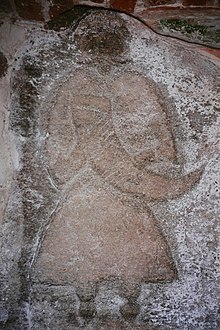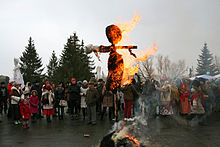Slavic paganism
From Wikipedia, the free encyclopedia
Jump to navigationJump to search
"Slavic religion" redirects here. For other uses, see Slavic religion (disambiguation).

A priest of Svantevit depicted on a stone from Arkona, now in the church of Altenkirchen, Rügen.
Slavic paganism or Slavic religion describes the religious beliefs, myths and ritual practices of the Slavs before Christianisation, which occurred at various stages between the 8th and the 13th century.[1] The South Slavs, who likely settled in the Balkan Peninsula during the 6th–7th centuries AD,[2] bordering with the Byzantine Empire to the south, came under the sphere of influence of Eastern Orthodox Christianity, beginning with the creation of writing systems for Slavic languages (first Glagolitic, and then Cyrillic script) in 855 by the brothers Saints Cyril and Methodius and the adoption of Christianity in Bulgaria in 863. The East Slavs followed with the official adoption in 988 by Vladimir the Great of Kievan Rus'.[3]
The West Slavs' process of Christianization was more gradual and complicated. The Moravians accepted Christianity as early as 831, the Bohemian dukes followed in 845, Slovaks accepted Christianity somewhere between the years 828 and 863[4], but the Poles accepted it much later, in 966, around the same time as the Sorbs, and the Polabian Slavs only came under the significant influence of the Roman Catholic Church from the 12th century onwards. For them and the Sorbs, Christianisation went hand in hand with full or partial Germanisation.[5][dubious – discuss]
The Christianisation of the Slavic peoples was, however, a slow and—in many cases—superficial phenomenon, especially in what is today Russia. Christianisation was vigorous in western and central parts of what is today Ukraine, since they were closer to the capital, Kyiv. Even there, however, popular resistance led by volkhvs, pagan priests or shamans, recurred periodically for centuries.[3]
The West Slavs of the Baltic tenaciously withstood Christianity until it was violently imposed on them through the Northern Crusades.[5] Among Poles and East Slavs, rebellions broke out throughout the 11th century.[1] Christian chroniclers reported that the Slavs regularly re-embraced their original religion (relapsi sunt denuo ad paganismus).[6]
Many elements of the indigenous Slavic religion were officially incorporated into Slavic Christianity (which manifested itself in the architecture of the Russian Church, icon painting, etc.),[3] and, besides this, the worship of Slavic gods has persisted in unofficial folk religion until modern times.[7] The Slavs' resistance to Christianity gave rise to a "whimsical syncretism" which in Old Church Slavonic vocabulary was defined as dvoeverie, "double faith".[1] Since the early 20th century, Slavic folk religion has undergone an organised reinvention and reincorporation in the movement of Slavic Native Faith (Rodnovery).
Contents
1Sources
1.1Foreign sources
1.2Slavic sources
1.3Modern sources
2Overview and common features
2.1Origins and other influences
2.2God and spirits
2.3Cosmology, iconography, temples and rites
3History
3.1Kievan Rus' official religion and popular cults
3.2Christianisation of the East Slavs
3.2.1Volodymyr's baptism, popular resistance and syncretism
3.2.2Continuity of Slavic religion in Russia up to the 15th century
3.2.3Sunwise Slavic religion, withershins Christianity, and Old Belief
3.3Christianization of the West Slavs
3.4Slavic folk religion
3.5Modern Rodnovery
4Reconstructed calendar of celebrations
5Influence on Christian Art and Architecture
6See also
7Notes
8References
8.1Citations
8.2Sources
8.3Further reading
Slavic folk religion[edit]
Ethnography in late-nineteenth-century Ukraine documented a "thorough synthesis of pagan and Christian elements" in Slavic folk religion, a system often called "double belief" (Russian: dvoeverie, Ukrainian: dvovirya).[25] According to Bernshtam, dvoeverie is still used to this day in scholarly works to define Slavic folk religion, which is seen by certain scholars as having preserved much of pre-Christian Slavic religion, "poorly and transparently" covered by a Christianity that may be easily "stripped away" to reveal more or less "pure" patterns of the original faith.[75]
Since the collapse of the Soviet Union there has been a new wave of scholarly debate on the subjects of Slavic folk religion and dvoeverie. A. E. Musin, an academic and deacon of the Russian Orthodox Church, published an article about the "problem of double belief" as recently as 1991. In this article he divides scholars between those who say that Russian Orthodoxy adapted to entrenched indigenous faith, continuing the Soviet idea of an "undefeated paganism", and those who say that Russian Orthodoxy is an out-and-out syncretic religion.[76] Bernshtam challenges dualistic notions of dvoeverie and proposes interpreting broader Slavic religiosity as a mnogoverie ("multifaith") continuum, in which a higher layer of Orthodox Christian officialdom is alternated with a variety of "Old Beliefs" among the various strata of the population.[77]
According to Ivanits, nineteenth- and twentieth-century Slavic folk religion's central concern was fertility, propitiated with rites celebrating death and resurrection. Scholars of Slavic religion who focused on nineteenth-century folk religion were often led to mistakes such as the interpretation of Rod and Rozhanitsy as figures of a merely ancestral cult; however, in medieval documents Rod is equated with the ancient Egyptian god Osiris, representing a broader concept of natural generativity.[78] Belief in the holiness of Mat Syra Zemlya ("Damp Mother Earth") is another feature that has persisted into modern Slavic folk religion; up to the twentieth century, Russian peasants practiced a variety of rituals devoted to her and confessed their sins to her in the absence of a priest. Ivanits also reports that in the region of Volodymyr old people practiced a ritual asking Earth's forgiveness before their death. A number of scholars attributed the Russians' particular devotion to the Theotokos, the "Mother of God", to this still powerful pre-Christian substratum of devotion to a great mother goddess.[78]
Ivanits attributes the tenacity of synthetic Slavic folk religion to an exceptionality of Slavs and of Russia in particular, compared to other European countries; "the Russian case is extreme", she says, because Russia—especially the vastness of rural Russia—neither lived the intellectual upheavals of the Renaissance, nor the Reformation, nor the Age of Enlightenment, which severely weakened folk spirituality in the rest of Europe.[79]
Slavic folk religious festivals and rites reflect the times of the ancient pagan calendar. For instance, the Christmas period is marked by the rites of Koliada, characterised by the element of fire, processions and ritual drama, offerings of food and drink to the ancestors. Spring and summer rites are characterised by fire- and water-related imagery spinning around the figures of the gods Yarilo, Kupala and Marzanna. The switching of seasonal spirits is celebrated through the interaction of effigies of these spirits and the elements which symbolise the coming season, such as by burning, drowning or setting the effigies onto water, and the "rolling of burning wheels of straw down into rivers".[25]
=
=
Monday, September 28, 2015
How the Slavs worship trees Worshiping trees is common for many ethnic groups and religions, and Slavs are no exception, since Slavs lived in an area covered with dense forests.
Worshiping trees is common for many ethnic groups and religions, and Slavs are no exception, since Slavs lived in an area covered with dense forests.
The cult of sacred trees was widely spread and strong among Slavs. The statue of Gods and temples were made from wood. It was believed that trees have magic power, probably because of its longevity and ability of regeneration.
The tree is considered as symbol of the universe as well as youth, wisdom, life, fertility, immortality. It was believed that trees are dwelling places for souls.
Slavic tribes had strong connection with nature and they believed in many gods that were patrons of forest, meadows, flowers, earth, sun… They also believed that every plant has a soul. Different sort of trees were subject of worshiping and sometimes forest was used instead of temples.
In front of the tree various rituals and celebrations were performed. Those trees had status of sacred ones and no one was allowed to cut or took any part of them, afraid of revenge of the spirits who lived inside the tree. If anyone broke this rule it was believed that he or some of his family members will die or have an accident.
Almost every village had its sacred tree. The rituals that were performed consisted of prayer, adorning tree with flowers, red strings and fruits. The sacred tree was patron of the village and protected its inhabitants from the thunder, drought and flood. Under the tree people organized meetings where important decisions were made. One of the most sacred trees among Slavs was oak tree. It was considered as tree that belongs to God Perun, the main deity of Slavic pantheon. Besides oak, other sorts of trees were worshiped: pear, yew, hornbeam and linden.
Dendrolatry in Slavic religion
Worshiping of oak tree continued its existence until nowadays in Christmas tradition. Although Slavic tribes are baptized, they could not completely forget their pagan Gods, so they incorporated old religion with Christianity. On the Christmas Eve branches of the oak tree are ritually burned. They represent deity, the God of vegetation that is burned in order to be born again. This is a symbolical presentation of life cycle.
Sometimes instead of oak other sorts can be used like yew tree or beech. Before tree is burned it is treated like deity. The bread and wine are offered as sacrifice. These rituals have a goal to transfer the magic power of the tree to the people. During the burning of the tree people would wish happiness, wealth, health and fertility. It was believed that some trees can captivate the souls of the dead and be their dwelling place. Apple tree sometimes was planted on the graves because of its ability to keep the souls. Since in traditional beliefs trees had divine nature, it was thought that they can protect from illness and misfortunes.
The pieces of hawthorn wood were used as amulet since it was the most powerful in protecting from demons. On the other hand it was believed that in some trees lived demons, witches and other evil creatures. Nut tree belonged to the underworld and demons, and it was never planted near houses. Linden forests were also cult places among Slavs.
The statues of gods were made from the linden wood, under the tree – weddings were celebrated. Yew tree is, according to legends, “fairy tree” and protects from demons, curses, witches and other evil forces. The pieces of yew tree were used as amulet for protection of people and cattle. Maple tree was also sacred tree associated with cult of the dead and ancestor cult. In the past, people were buried in hollow maple timber in order that tree protects soul from demons in the afterlife. Although Slavic people started being baptized centuries ago, the cult of tree survived until nowadays and is incorporated in Christian tradition.
Posted by Unknown at Monday, September 28, 2015
Labels: Bog Sloveni rod otac majka tvorac Badnjak, celebrate, God, keeper, Oak, people, Perun, sacred, Slavs, Svetovid, symbol, tradition, Tree

